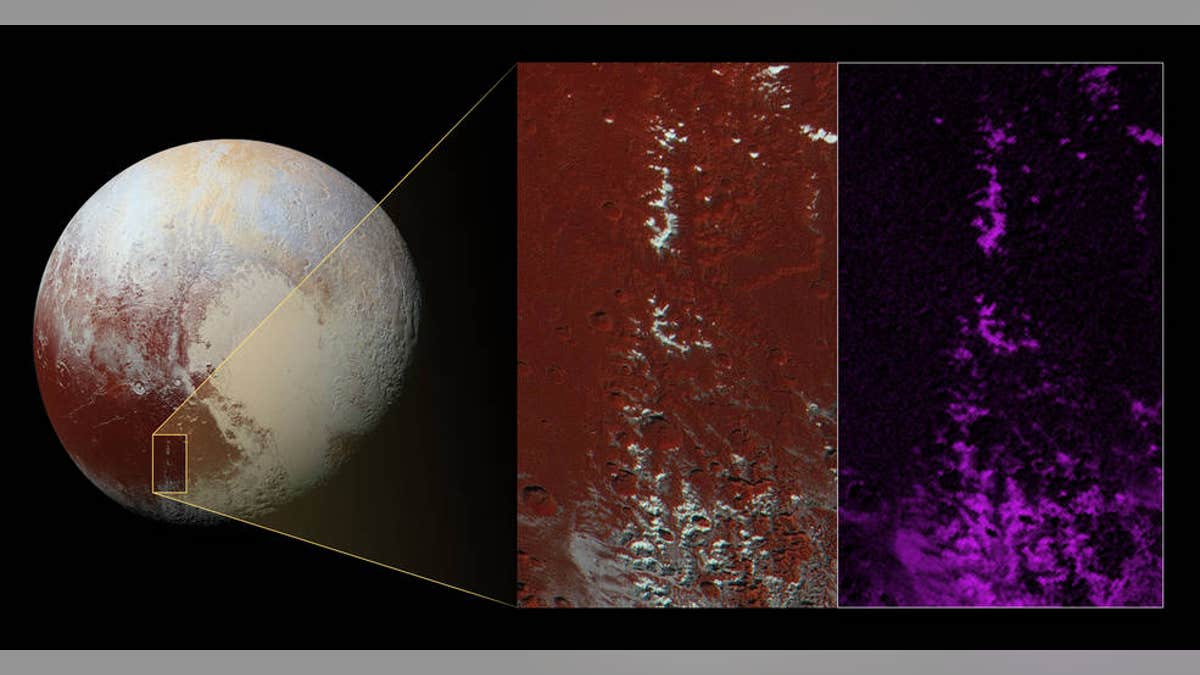
The New Horizons team has discovered a chain of exotic snowcapped mountains stretching across the dark expanse on Pluto informally named Cthulhu Regio. (NASA)
Scientists with NASA’s New Horizon spacecraft have discovered a mountain range on Pluto that is a bit larger than the state of Alaska and may be covered with methane-infused snow.
It’s been named Cthulhu (pronounced kuh-THU-lu) and stretches nearly halfway around Pluto’s equator, starting from the west of the great nitrogen ice plains known as Sputnik Planum. It measures a whopping 1,850 miles long and 450 miles wide.
Cthulhu’s dark surface is possibly the result of being covered by a layer of dark tholins – complex molecules that form when methane is exposed to sunlight. Cthulhu’s geology features mountainous to smooth regions as well as heavily cratered to fractured areas.
Related: New Pluto photos show breathtaking views of dwarf planet
The reddish enhanced color of the image (included above) shown as the left inset reveals a mountain range located in southeast Cthulhu that’s 260 miles long. The range is situated among craters, with narrow valleys separating its peaks. The upper slopes of the highest peaks are coated with a bright material that contrasts sharply with the dark red color of the surrounding plains.
The bright material could be mostly methane, since the location of the bright ice on the mountain peaks correlates almost exactly with the distribution of methane ice, shown in false color as purple.
"That this material coats only the upper slopes of the peaks suggests methane ice may act like water in Earth's atmosphere, condensing as frost at high altitude," John Stansberry, a New Horizons science team member from Space Telescope Science Institute, Baltimore, Maryland, said in a statement.
Related: Cool NASA images reveal day in the life of Pluto
The image was obtained by New Horizons at a range of approximately 21,100 miles from Pluto, about 45 minutes before the spacecraft’s closest approach to Pluto on July 14.
Pluto has fascinated astronomers since 1930, when it was discovered by Clyde Tombaugh using the Lowell Observatory in Flagstaff, Ariz. Some of Tombaugh's ashes are aboard New Horizons. It has since been demoted to a dwarf planet.
Last year, New Horizons became the first-ever space mission to explore a world so far away from Earth when reached Pluto.
The spacecraft's flyby of Pluto and its five known moons is providing valuable insight into the solar system's Kuiper Belt, which contains icy objects that range in size from boulders to dwarf planets, NASA said. Kuiper Belt objects, such as Pluto, can preserve evidence about the early formation of the solar system.
It is also giving scientists a good look at Pluto’s fascinating and abundant geological activity.
Related: NASA: Pluto has hills of water ice 'floating' on a sea of frozen nitrogen
Last month, NASA announced that Pluto’s nitrogen glaciers may contain water from its uplands. Measuring one to several miles across, the hills are in the vast ice plain informally named Sputnik Planum within Pluto’s ‘heart,’ are likely miniature versions of the larger, jumbled mountains on Sputnik Planum’s western border.




















